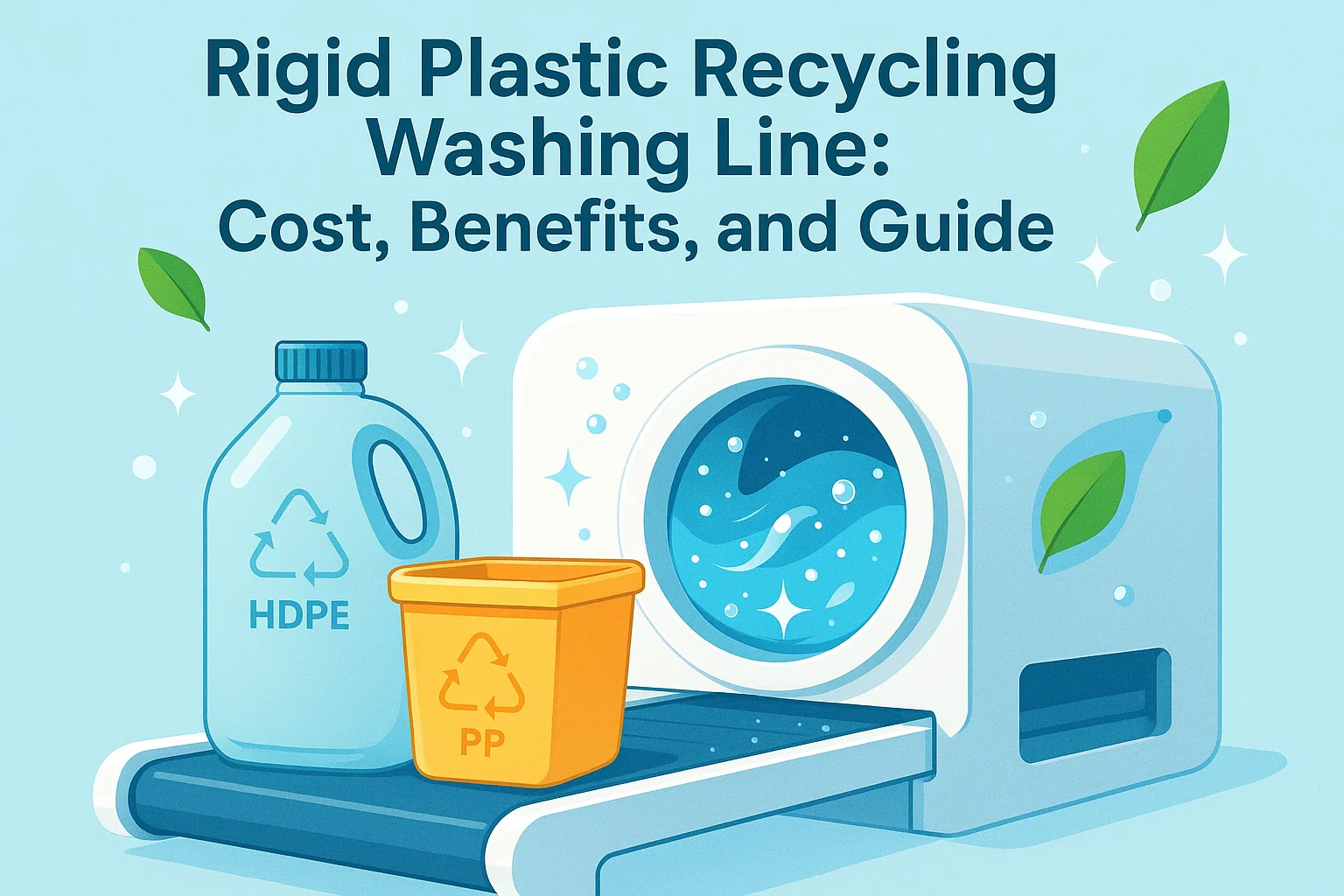Con la sostenibilità sempre più al centro dell'attenzione in tutto il mondo, il settore del riciclo della plastica è in rapida crescita. Per le aziende che mirano a gestire i rifiuti plastici in modo responsabile e redditizio, investire in un stendibiancheria per il riciclaggio di plastica rigida è una decisione fondamentale. Ma quanto costa e cosa aspettarsi durante l'acquisto e la gestione operativa? Questa guida completa fornisce tutto ciò che è necessario sapere, dalla scelta delle attrezzature alle spese operative, per permetterti di fare un investimento consapevole.
Cos'è uno stendino in plastica rigida?
UN filo per stendere in plastica rigida è un sistema integrato di macchine progettato per pulire e processare materiali plastici rigidi come HDPE (polietilene ad alta densità) e PP (polipropilene). Queste plastiche si trovano comunemente in articoli come bottiglie, casse e componenti automobilistici. La funzione principale della linea di lavaggio è rimuovere i contaminanti e preparare la plastica per il riciclaggio in nuovi prodotti. I componenti tipici includono trituratori, vasche di lavaggio, lavatrici a frizione, vasche di flottazione e unità di asciugatura.
Scopri di più sulla tecnologia alla base di questi sistemi sul nostro pagina di stendibiancheria in plastica rigida.
Fattori chiave che influenzano il costo di uno stendibiancheria in plastica rigida
Diverse variabili influenzano il prezzo di uno stendibiancheria rigido in plastica. Comprendere questi fattori ti aiuterà a scegliere la soluzione più adatta alle tue esigenze e al tuo budget.
1. Qualità dell'attrezzatura
Macchine di alta qualità rappresentano un investimento in efficienza, affidabilità e longevità. Le linee prodotte in Europa sono spesso associate a una qualità costruttiva superiore, ma in tutto il mondo sono disponibili eccellenti opzioni di produttori affidabili. È importante ricordare che costi iniziali più elevati si traducono spesso in una minore manutenzione e in migliori prestazioni nel tempo.
2. Capacità
Le linee di lavaggio vengono dimensionate in base alla portata, solitamente misurata in chilogrammi all'ora (kg/h). I sistemi più piccoli, perfetti per startup o piccole imprese, possono gestire 500 kg/h. Le aziende più grandi potrebbero aver bisogno di linee con una capacità superiore a 2.000 kg/h. Maggiore è la capacità, maggiore è il prezzo.
3. Personalizzazione
Ogni operazione di riciclo è unica. Le linee di lavaggio personalizzate possono essere adattate per trattare specifici tipi di plastica o per affrontare diversi livelli di contaminazione. La personalizzazione aumenta i costi, ma garantisce che il sistema soddisfi esattamente i vostri requisiti.
4. Funzionalità aggiuntive
Funzionalità avanzate come il monitoraggio automatizzato, i motori a basso consumo energetico o i sistemi di riciclo dell'acqua possono incrementare l'investimento iniziale, riducendo al contempo i costi operativi correnti. Questi miglioramenti migliorano l'efficienza, riducono gli sprechi e possono offrire risparmi significativi nel lungo periodo.
Tipi di linee di lavaggio in plastica rigida
Aziende diverse richiedono soluzioni diverse. Ecco le tipologie più comuni:
Stendibiancheria rigido di base in plastica
Ideale per i principianti, questa configurazione include in genere un trituratore, una vasca di lavaggio, una lavatrice a frizione e un'asciugatrice. Copre le fasi essenziali per una pulizia e un trattamento efficaci a un prezzo base accessibile.
Stendibiancheria in plastica rigida avanzata
Le linee avanzate offrono fasi aggiuntive di pulizia e asciugatura, come lavatrici a caldo per contaminazioni ostinate o vasche di lavaggio secondarie, per operazioni che richiedono un output riciclato ad alta purezza.
Stendibiancheria in plastica rigida personalizzata
Linee completamente personalizzabili sono progettate per affrontare sfide specifiche, come la rimozione di contaminanti speciali o la lavorazione di plastiche rigide non comuni. Spesso sono dotate di trituratori specializzati, trattamento delle acque integrato o automazione avanzata.
Fascia di prezzo: quanto dovresti aspettarti di pagare?
Sebbene i prezzi varino a seconda della configurazione, ecco una guida generale:
- Stendibiancheria rigido di base in plastica: $50.000 – $150.000
- Stendibiancheria in plastica rigida avanzata: $150.000 – $300.000
- Stendibiancheria in plastica rigida personalizzata: $300.000 e oltre
Queste cifre possono variare a seconda del fornitore, della regione e delle opzioni specifiche. Sebbene l'investimento possa sembrare significativo, molte aziende ritengono che i benefici a lungo termine e il ritorno sull'investimento ne siano ampiamente giustificati.
Costi operativi in corso
Oltre all'acquisto iniziale, considera queste spese ricorrenti:
Consumo energetico
Utilizzare uno stendino richiede molta energia. Sebbene i modelli a basso consumo energetico possano avere prezzi di acquisto più elevati, possono ridurre le bollette mensili e offrire vantaggi ambientali.
Manutenzione
Una manutenzione regolare è fondamentale per massimizzare i tempi di attività e prolungare la durata delle apparecchiature. Pianificare ispezioni periodiche, sostituzioni di componenti e interventi di manutenzione professionale occasionali.
Lavoro
Operatori qualificati sono essenziali per l'efficienza della linea di riciclaggio. Investire nella formazione del personale e in una gestione efficiente del flusso di lavoro contribuirà a mantenere i costi di manodopera gestibili.
Smaltimento dei rifiuti
Gestire e smaltire correttamente i contaminanti e i materiali non riciclabili è una necessità sia normativa che ambientale. Considerate questi costi quando stilate il budget per le vostre attività di riciclaggio.
Massimizzare il ritorno sull'investimento (ROI)
UN filo per stendere in plastica rigida può generare un ROI elevato con la giusta strategia. Ecco alcune best practice:
Analisi di mercato
Informatevi sulla domanda locale di plastica rigida riciclata. Stabilire relazioni con gli acquirenti e stipulare contratti garantirà un flusso di entrate costante.
Controllo di qualità
Un output costante e di alta qualità crea fiducia e fidelizzazione dei clienti. Implementate un rigoroso controllo qualità in ogni fase del processo.
Operazioni efficienti
Ottimizzare per ridurre al minimo gli sprechi e massimizzare l'efficienza energetica. I miglioramenti continui dei processi possono aumentare la produttività e i profitti.
Impatto ambientale
Promuovere il contributo ambientale positivo della tua azienda può rafforzare il tuo marchio e aprire le porte a clienti e partner attenti all'ambiente.
Uno sguardo più da vicino: il processo di lavaggio della plastica rigida
Ecco una panoramica dettagliata di come questi sistemi trasformano i rifiuti di plastica:
1. Triturazione
I rifiuti di plastica vengono sminuzzati in pezzi più piccoli, rendendoli più facili da pulire e da lavorare.
2. Lavaggio
Diverse fasi di lavaggio, tra cui vasche, lavatrici a frizione e lavatrici a caldo, rimuovono etichette, sporco e oli per garantire fiocchi puri e privi di contaminanti.
3. Asciugatura
Le potenti unità di essiccazione riducono l'umidità, preparando i fiocchi di plastica per l'ulteriore lavorazione o la vendita diretta.
4. Ordinamento
Le linee avanzate possono includere la selezione automatizzata in base al tipo di plastica o al colore, migliorando la qualità e il valore di mercato del prodotto riciclato.
5. Pellettatura (facoltativo)
Alcune operazioni aggiungono una fase di pellettizzazione, trasformando i fiocchi puliti in pellet uniformi per una maggiore attrattiva sul mercato.
Domande frequenti
D: Quali tipi di plastica possono essere lavorati?
UN: La maggior parte delle linee è progettata per HDPE, PP e altre plastiche rigide come casse, bottiglie e componenti per autoveicoli.
D: Quanto tempo richiede l'installazione?
UN: I tempi di installazione variano a seconda della complessità, ma si possono prevedere da diverse settimane ad alcuni mesi dall'ordine alla prontezza operativa.
D: Quali normative dovrei prendere in considerazione?
UN: È fondamentale rispettare le normative ambientali locali e internazionali, soprattutto per quanto riguarda lo smaltimento dei rifiuti e l'uso dell'energia.
D: Posso aggiornare la mia linea esistente?
UN: Molti produttori offrono kit di aggiornamento per migliorare l'efficienza, aumentare la capacità o soddisfare le nuove normative.
D: Quanto dura uno stendino?
UN: Con la dovuta cura, una linea di alta qualità può funzionare in modo efficiente per oltre 10 anni.
D: Sono disponibili opzioni di finanziamento?
UN: Sì! Molti fornitori offrono finanziamenti per rendere questi sistemi più accessibili.
Conclusione
UN stendibiancheria per il riciclaggio di plastica rigida è un investimento intelligente per qualsiasi azienda focalizzata su sostenibilità, redditività e conformità. Comprendendo i fattori che influenzano i costi, le esigenze operative e il potenziale ROI, puoi scegliere il sistema più adatto alle tue esigenze e posizionare la tua azienda per un successo a lungo termine. Se sei pronto a fare il passo successivo o desideri una consulenza esperta, esplora il nostro soluzioni per stendere i panni in plastica rigida Oggi.



